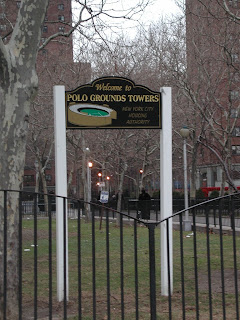 Diehard baseball fans still talk about “The Catch” that Willie Mays made at New York’s Polo Grounds in the 1954 World Series. But high-rise apartments now cover the ground where the stadium once stood, and the memory of Mays’s unearthly play 55 years ago is fading.
Diehard baseball fans still talk about “The Catch” that Willie Mays made at New York’s Polo Grounds in the 1954 World Series. But high-rise apartments now cover the ground where the stadium once stood, and the memory of Mays’s unearthly play 55 years ago is fading.Seattle artist Thom Ross wants to make sure that future generations of fans – especially New Yorkers – remember that moment when Mays did the impossible. He has created a life-sized five-part illustration of the feat that shows Mays from the moment he zeros in on the baseball that Cleveland’s Vic Wertz drove to the deepest part of the stadium until he whirls to throw the ball back to the infield after making the catch.Ross’s illustration of Mays's catch has twice gotten the attention of Sports Illustrated magazine, and he’d like to erect a permanent version of “The Catch” in New York at the spot where Mays performed his feat. He already has a permanent display at Safeco Field in Seattle showing the moment the Seattle Mariners beat the New York Yankees in the 1995 American League Division Series.
 Ross hauled his illustration across the U.S. and set it up temporarily at the Polo Grounds Towers last September. The photo at the top of this post shows Ross's display. The exhibit stirred the memories of some older residents who recalled the moment, but it bothered Ross that the kids who saw his work didn’t know anything about what had happened there.
Ross hauled his illustration across the U.S. and set it up temporarily at the Polo Grounds Towers last September. The photo at the top of this post shows Ross's display. The exhibit stirred the memories of some older residents who recalled the moment, but it bothered Ross that the kids who saw his work didn’t know anything about what had happened there.“The little kids that lived there, no one told them that Willie caught the ball where they played,” Ross told me recently. “These kids live in a sacred place, and there’s no one there to pass that story along.”
 To erect a permanent version of The Catch at the Polo Grounds Towers, however, he needs permission from New York City officials. He's tried to contact the office of Mayor Michael Bloomberg, but hasn't gotten a response.
To erect a permanent version of The Catch at the Polo Grounds Towers, however, he needs permission from New York City officials. He's tried to contact the office of Mayor Michael Bloomberg, but hasn't gotten a response.Ross and I have been talking about his effort since he recently saw my blog post about the trip I made to the site of the Polo Grounds a couple of years ago with my nephew John Morrow and brother-in-law Bob Morrow.

Around 54,000 people saw Wertz drive a long, towering fly ball to the deepest part of the Polo Grounds in the eighth inning of Game One of the 1954 World Series. Mays probably was the only person in the ballpark who thought the 460-foot blast could be caught. But his opinion was the one that mattered. To the amazement of the crowd and people who still watch the play on video today, Mays chased down the long drive and hauled it in at full gallop.
Jack Brickhouse, who was doing the radio play-by-play broadcast of the game, said Mays’s catch “must have been an optical illusion to a lot of people.” But Mays was nonchalant.
“I had the ball all the way,” Mays told reporters after the game. “There was nothing too hard about it. I’ve made better catches.”
Ross was a toddler living with his family in San Francisco in 1954. He recalls his father telling him about the catch, but he didn’t really become aware of Mays until the Giants moved to San Francisco in 1958 and played the New York Yankees in the 1962 World Series.
Ross sees a deeper meaning in Mays’s extraordinary play and thinks it’s “a beacon, and a challenge, to all people who dare to dream.”
The Catch also has become a personal inspiration for Ross.
“I was able to incorporate Willie and his Catch into my philosophy on my own life as an artist, and I saw that the same effort, talent and dedication would be demanded of me,” he says. “And because Mays did indeed catch the ball, I knew my own dreams and wishes were possible. It was all in how much I was willing to put out, what effort I was willing to do.”
(Photo of Mays's catch in 1954 World Series is a Wide World photo)






